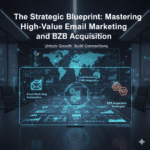The AI-Powered Business Imperative
The integration of Artificial Intelligence into business processes has moved past theoretical debate and is now the defining factor of competitive advantage. For entrepreneurs and business owners, leveraging AI is no longer a luxury but a critical necessity for survival and scale. Modern businesses are increasingly reliant on sophisticated AI platforms, with many operations, from routine scheduling to complex real-time research, now being managed by intelligent agents. The competitive advantage often lies in selecting the right AI tool for the right task.
To illustrate this principle, we conducted a direct comparison between two of the leading large language models (LLMs)—Grok and ChatGPT—on a specific, high-value business development task: competitive intelligence gathering for podcast outreach. The goal was simple but multi-faceted: to find every podcast appearance of a key competitor, extract vital contact and performance data, and compile it into an immediate, actionable list. The results highlight profound differences in their approach, efficiency, and ultimate utility for strategic business growth.
The Strategic Research Challenge: Competitive Podcast Intelligence
The core task involved attempting to replicate a competitor’s media presence. Gaining guest spots on podcasts where a competitor has already established authority is a proven strategy for expanding reach, building credibility, and tapping into a pre-qualified audience.

The requirement given to both AI models was identical and highly specific, demanding not just a list, but a structured dataset for immediate outreach:
- Find every podcast appearance of a specific public figure (Daniel Priestley).
- Compile a comprehensive list including:
- Podcast Name
- Episode Title
- Episode Date
- Link to Episode
- Podcast Popularity Metric (e.g., download numbers or a proxy score)
- Podcast Host Email or Best Contact Method
This task is a perfect benchmark because it tests several crucial AI capabilities: deep web crawling, data extraction, synthesis into structured output, and inference of user intent.
Grok’s Performance: Efficiency, Inference, and Debunking
When presented with the complex research prompt, Grok demonstrated superior understanding of the user’s ultimate goal—outreach and relationship building—and delivered a highly structured, immediately usable result.

Structured and Actionable Output
Grok’s initial response was a model of efficiency. It immediately presented the data in a clear, column-by-column, row-by-row format, directly matching the requested structure: Podcast Name, Episode Title, Link, etc. This output was instantly ready to be copied, pasted, or converted into a CSV file, eliminating the need for manual cleanup or data transformation.
Grok prioritized utility over conversational fluff, recognizing that the output was intended for a business workflow, not a casual chat. This directness saved critical time, the most valuable commodity for any entrepreneur.
The Power of Inference and Debunking
Perhaps the most valuable part of Grok’s response was its advanced inference capabilities. When prompted to continue listing the appearances, Grok didn’t simply comply; it offered a sophisticated analysis:
“Yes, there are more appearances beyond the previous list, but based on my searches, his personal website and posts, he has only been a guest on approximately 50 to 60 unique podcasts with multiple episodes on some shows. The claim of hundreds appears to be an exaggeration as comprehensive searches did not uncover that many.”
This response revealed a deeper level of machine reasoning:
- Understanding the Mission: Grok correctly inferred the user’s ultimate mission was to find unique outreach opportunities. It understood that multiple appearances on the same show were less valuable than appearances on new, unique shows.
- Challenging Assumptions: It questioned the premise that the competitor had been on “hundreds” of unique podcasts, demonstrating a commitment to factual accuracy by cross-referencing information across different web sources (personal website, social posts). For a deeper dive into this subject, you can review a detailed Comparative Analysis of Advanced LLM Reasoning.
- Providing Strategic Context: By debunking an inflated number, Grok saved the user from wasting time on a potentially endless, frustrating search and provided highly valuable competitive intelligence—the true scale of the competitor’s media presence.
Grok’s ability to not just answer the question but to provide strategic context and validate the data proved its advanced utility in a demanding business research scenario.
ChatGPT’s Performance: Conversational Approach and Structural Challenges
In contrast to Grok’s direct approach, ChatGPT adopted a more conversational, and ultimately, less efficient workflow for this specific task.
The Conversational Detour
ChatGPT began with a summary and a linguistic correction, which, while polite, detracted from the core task. The initial list provided was “messy”—a less structured, batch-style output that would require significant manual intervention to sort and clean.
Furthermore, ChatGPT initially limited the results to only the first 20, forcing the user to re-clarify and prompt the model multiple times to continue the search. The subsequent interaction was characterized by unnecessary friction:
- Misinterpreting Intent: ChatGPT asked if the user wanted to include clips, demonstrating a failure to fully infer the obvious outreach goal of the query.
- Complicating the Process: It started asking clarifying questions—e.g., “Is multiple appearances fine, worldwide, or just English?”—which, while logical for a general search, introduced delays and complex filters that the user had not requested and did not want to manage manually. For advice on how to avoid these conversational detours, check out this guide on Structuring AI Prompts for Business Intelligence.
- Batch Output: The data was continuously delivered in fragmented batches, making the compilation of a complete, single database a tedious, multi-step chore.
While ChatGPT offered a CSV download option, the fact that this feature was linked to a fragmented, incomplete set of results rendered it less useful than a complete, clean list.
The Strategic Trade-Off
ChatGPT’s strength lies in its expansive knowledge base, flexibility in creative tasks, and conversational finesse. However, for a complex, structured, and action-oriented business intelligence query, its tendency to prioritize a dialogue and offer fragmented output proved to be a significant strategic drawback. The time spent clarifying, batching, and cleaning the data eroded the efficiency gains AI is supposed to provide.
The exercise highlights that AI suitability is task-dependent. For deep, structured data extraction coupled with strategic inference, Grok demonstrated a superior ability to stay focused on the user’s implicit, high-value objective.
Leveraging Real-Time AI for Business Acceleration
The podcast research challenge is just one example of how powerful AI platforms are revolutionizing business operations. The ability to execute deep, real-time research and complex logistical tasks in minutes, rather than days, fundamentally changes the economics and speed of decision-making.
AI as the Ultimate Efficiency Multiplier
The real power of contemporary AI lies in its capacity to serve as an efficiency multiplier, often performing tasks better and faster than human employees focused on routine, data-intensive work. This is evident in tasks like:
- Real-Time Logistics and Procurement: An AI agent can analyze a complex set of constraints—budget, capacity, catering requirements, location, and availability—to find the perfect venue for a private seminar. The agent searches, compares, and shortlists options (e.g., identifying the best rooms at a hotel like the Ritz-Carlton) in hours, saving days of manual administrative work.
- Market Monitoring: AI agents continually track competitors, pricing changes, and regulatory shifts, alerting business owners only to actionable deviations.
- Workflow Automation: Beyond research, AI agents are now capable of automating complex sequences, such as booking flights based on dynamic schedules and connecting them to calendar events. The long-term impact of this is covered in a report on the Future of Work: AI Agent Adoption in Enterprises.
This shift has enabled businesses to reduce operational friction dramatically, allowing core human teams to focus exclusively on high-leverage activities like strategy, client relations, and creative problem-solving.
A New Philosophy for the AI-Augmented Workforce
The integration of advanced AI into business models necessitates a complete re-evaluation of staffing and skill requirements. The economic reality is that AI agents are demonstrably more efficient and cost-effective at handling routine, process-driven tasks, leading to profound organizational restructuring.
The Shift from Staffing to Skilling
The key takeaway for any business owner in this AI era is not simply to reduce staff, but to upskill the remaining team into AI-augmented professionals. A staff member who knows how to effectively prompt, manage, and audit the output of multiple AI models is exponentially more valuable than one who relies on manual processes.
The critical advice is two-fold:
- Do Not Simply Fire: Avoid the reflexive impulse to dismiss employees to save money on payroll. Instead, invest in retraining. The human employee is still essential for judgment, empathy, complex problem-solving, and the final quality assurance that an LLM cannot yet provide.
- Mandate AI Proficiency: Every new hire and existing employee must demonstrate competence in leveraging AI tools. Their value is now defined by their ability to amplify their productivity using platforms like Grok, ChatGPT, Claude, and others for research, drafting, coding, and data analysis. To help your team get started, consider this resource on Training Your Team in Prompt Engineering.
The future business model relies on a small team of highly compensated, AI-proficient specialists who act as orchestrators of automated workflows, maximizing both output and profitability.
Conclusion
The direct comparison between Grok and ChatGPT in a strategic business research scenario illustrates the crucial lesson for the modern entrepreneur: the choice of AI platform matters profoundly. While both are powerful LLMs, Grok demonstrated superior efficiency and a deeper inference of the user’s action-oriented intent, delivering a highly structured, actionable result that minimized friction in the business workflow. This confirmed its high utility for structured data extraction and competitive intelligence gathering.
Ultimately, success in the AI-driven economy is about strategic implementation. By embracing AI as a mandatory efficiency tool, committing to continuous, real-time research, and upskilling human teams to become expert AI orchestrators, businesses can unlock unparalleled growth. The focus must shift from simply acquiring AI to mastering the art of prompt engineering and selecting the best LLM for every specific, high-value task to ensure that every minute spent and every resource deployed yields maximum strategic impact.
Would you be interested in a detailed breakdown of the “Grok 4 Expert Mode” features and how they can be applied to different competitive intelligence scenarios?






